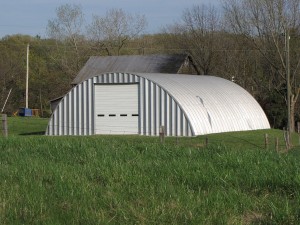While waffling about the Quonset Hut, I discovered that steel buildings in general offer many advantages, regardless of how they are constructed.
Steel is quite strong for its’ weight, and relatively easy to shape. Repairs are simple. While steel can rust, modern coatings (Galvanization, paints and polymers), provide a durable surface that is reasonably rust resistant for up to 50 years and sometimes beyond.

Steel panels are completely waterproof, except for where they articulate, and any perforations through them (like where bolts or screws go through them to attach them to each other or to a frame).
These exceptions can be mostly overcome by clever design, neoprene washers and careful assembly. That said, if presented with 150 mph horizontal wind and torrential rain, even the cleverest design will probably leak some. But I don’t expect a hurricane in Southern Illinois.
Coated steel panels are relatively energy-efficient, reflecting as much as 90% of infrared radiation away from the panel. If backed by a thin, plastic sheet, additional energy reflection and a layer of air trapping will prevent the worst of the heating of the steel in the summer.
Interior condensation can be a challenge for steel buildings, but this can be mitigated by using a plastic sheet (vapor barrier) underneath the concrete floor, and ventilation (ideally passive, but active if necessary).
From an environmental view, steel panels are a renewable, reusable resource. The panels themselves likely contain at least some recycled steel, and when their useful life is over, they can be sent back to the smelter for reuse.
So while I like the idea of constructing a steel building in the woods to store my forestry equipment, tools, fuel and chemicals, I still was having second thoughts about Quonset Huts.
So I decided to investigate the alternatives of all steel garages and steel covered pole barn structures.
